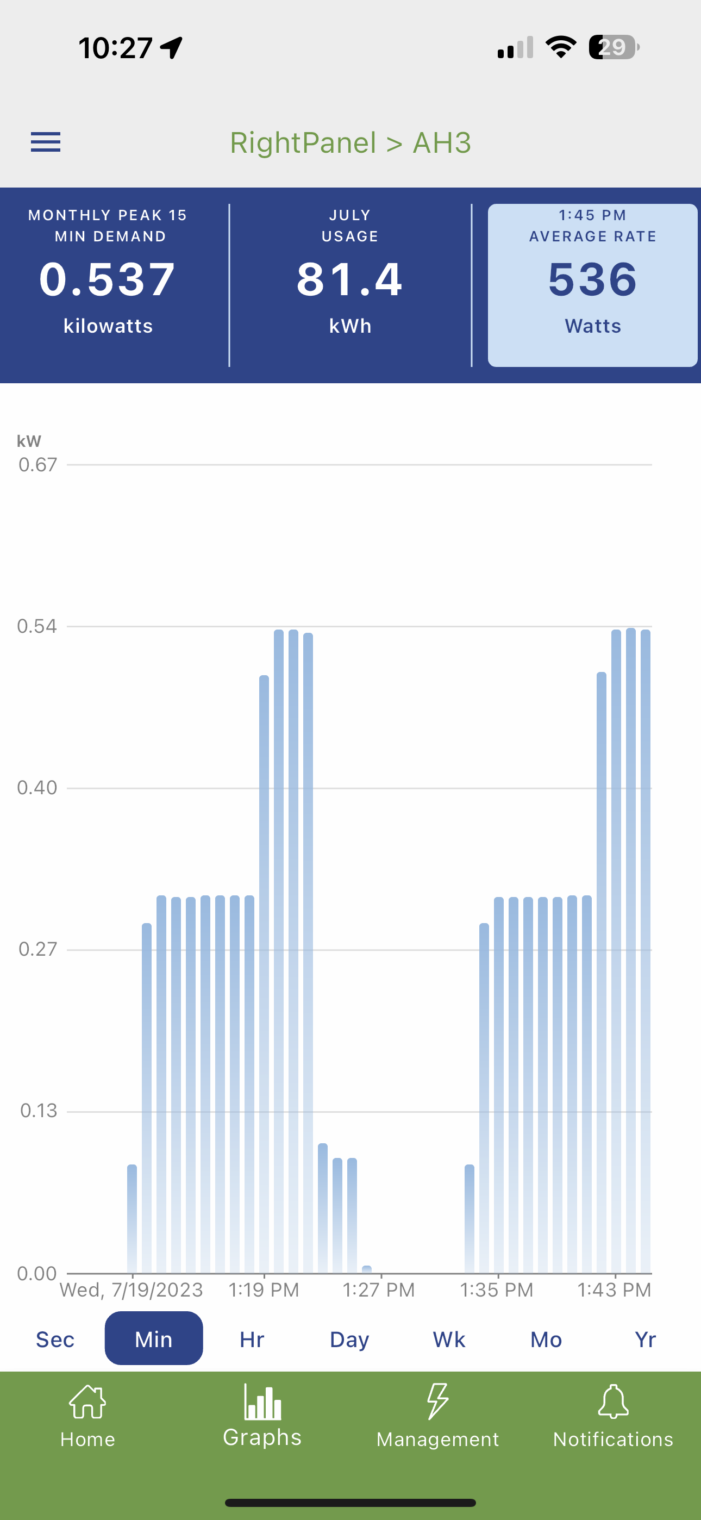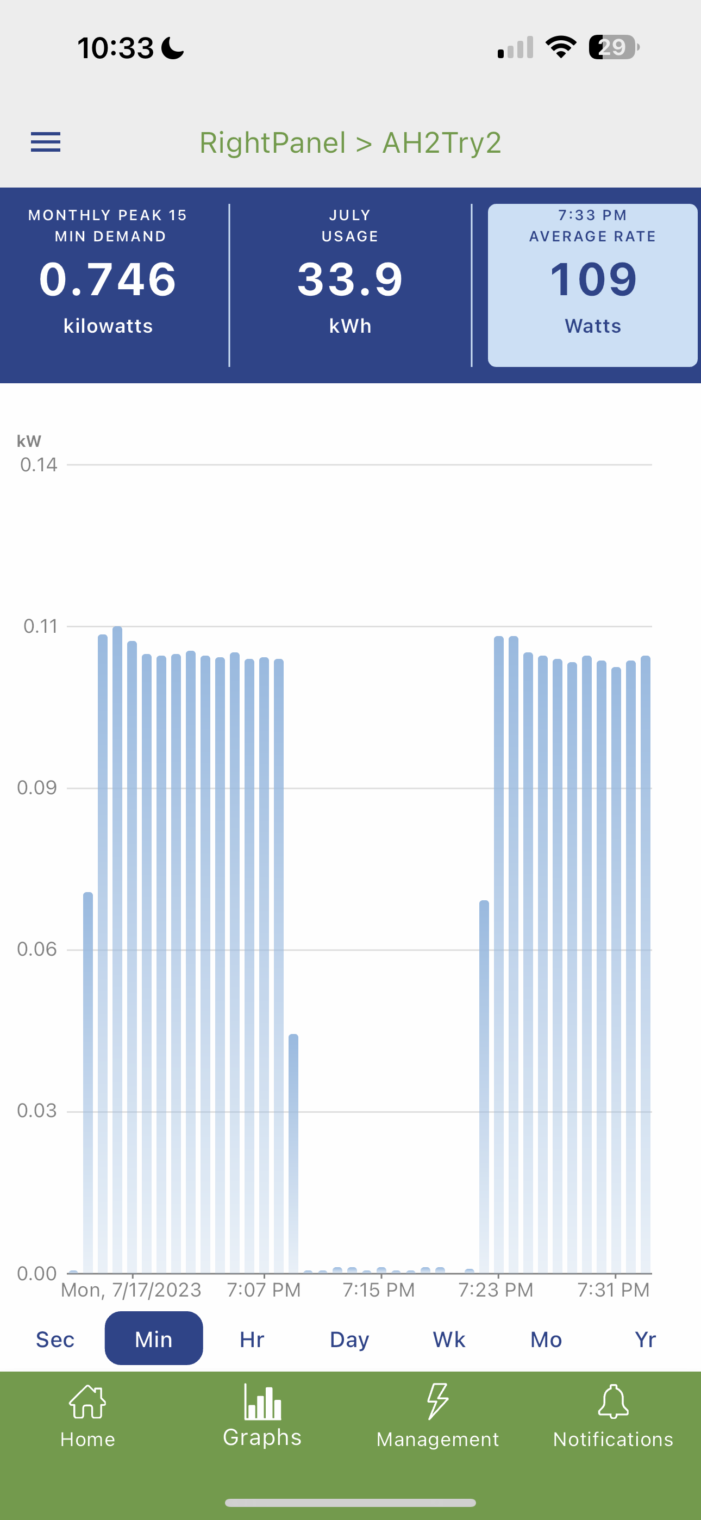I’ve been trying to reengineer the air conditioning in our house to match the new(ish) reduced cooling load after a hurricane low-E glass window retrofit by the previous owner (see ChatGPT is almost as bad at home maintenance as I am). Before I downsized the system, however, I decided that I had better make sure that the theoretical Manual J calculations of an 8.5-ton demand were correct. The goal was to see what percentage of the time the 12-ton current system (divided into three condensers/air-handlers) was running on hot days (e.g., when the NYT says South Florida is facing EXTREME DANGER).
I decided to install an inductive current monitor in the circuit breaker panel that could watch all three air handler breakers, specifically the Emporia Vue 2. This is supposed to be easy to install oneself and I have a Ph.D. in Electrical Engineering… so I decided to hire an electrician to do it properly. It took him less than one hour and he never shut off power to the panel, as the instructions suggest.
The software is reasonably good, but setup operations take longer to complete than you’d expect. Budget perhaps 30 minutes to get it all connected to WiFi and then to rename the ports. Here’s our Air Handler 3, a 3-ton system, on a day that was 125 degrees (NYT) or 91 degrees (Google/Apple). We can see that the variable-speed air handler (sadly, connected to a one-speed condenser) ramps up to about 500 watts and also that it is running most of the time (the calculated current demand for the upstairs was just 2.3 tons).
Here’s the a 5-ton air handler:
It’s drawing only 100 watts. Notice that I called it “AH2Try2” because I replaced the probe (myself!) and connected it to a different port because I assumed that the Emporia device was bad.
The installation guide for the Trane TEM6 air handler says that it should be drawing at least 500 watts:
I found that the unit was sweating on the outside and, opening it up, mildewing on the inside. The A/C contractor did the following:
- replaced the blower (covered under warranty by Trane)
- took the air handler apart and cleaned it
- pumped out the refrigerant and cut the evaporator coil out and brought it down to the side yard and cleaned it thoroughly
- cleaned out the air handler interior
- replaced the plenum
- replaced a failed UV sterilizer that had been in the old plenum with a REME HALO
With the new fan in place, power consumption went up to over 700 watts and the cabinet stopped sweating.
Given that air handlers are hard-wired, I don’t know of any other way to verify that they’re working properly. The regular A/C service guys don’t measure airflow carefully. And the power monitor is fun to have for investigating random appliance power consumption questions. Our 20-year-old last-legs KitchenAid refrigerator is consuming only 75 watts, for example.
What if you don’t want to spend $250-ish, including an electrician’s time? You can spend $thousands to replace your whole breaker panel and/or all of the breakers with “WiFi breakers”. Span will sell you a panel for $4,500 (plus the breakers?). Can you guess where this new company is located?
Eaton, which has been making panels for about 100 years, sells individual WiFi breakers that can report consumption and also be reset remotely. These seem to cost about $250 each, but if you already have an Eaton panel the installation could be cheap and simple.
Leviton makes a comprehensive system, but it will require replacing your panel(s). The panels themselves from Leviton seem to be cheap (less than $200). Once that’s done, an individual breaker can be as cheap as $54. Our electrician put this system in his own house and likes it.
Speaking of breakers, how long do they last in your experience? Our panels have spent 20 years in a hot/humid garage and the Cutler Hammer breakers inside don’t seem to be happy about it. Especially if a big one trips or is toggled it will tend to require replacement.




@PhilipGreenspun
Would you like help? Feel free to reach out.
HVAC 101 basics PDF – bit.ly/HVAC101File1118
70 second video on Duct Pressure – bit.ly/DuctPressure
4 minute video on 6 HVAC functions – bit.ly/HVAC6Functions
philip.greenspun.com/blog/2023/08/0…
https://ts.la/ted35517
YouTube channel;
https://youtube.com/@hvac2.038?feature=share9
“20-year-old last-legs KitchenAid refrigerator”
The newer of my parents’ refrigerators was over 20 years old when your KitchenAid was new; Aren’t they supposed to live forever?
Perhaps, the blower was the only thing that had to be replaced. Sweating on the outside indicates that humidity outside is too high due to insufficient CFM to absorb moisture.. Did you measure humidity ?
Maybe the UV sterilizer, but the rest looks fishy.
Ivan: I agree with you that the blower replacement alone could have solved 90% of the problem.
Did anyone check and or remove the air filters? Many modern air filters look OK when they are really blocked. Low air flow and humidity build up can be caused by low air flow due to dirty filters……
Bill: These systems have simple 1″ air filters that get replaced every three months (also, the drain lines get vacuumed out every three months; Florida is a tough environment for A/C!).
Phil, the new equipment is very sensitive to static pressure. Over 1/2 inch of water column will put expensive EC Motors at risk (and burn a lot of electricity).
4″ filters will dramatically lower pressure drop at the filter.
70 second video on Duct Pressure – bit.ly/DuctPressure
This is how we are designing systems to reduce likelihood of airflow problems:
https://www.natethehousewhisperer.com/blog/bad-ass-hvac-part-1
Ted: I know that 1″ filters are the ghetto standard, but that’s how the house and system were designed. The filters live in the return grilles. I can’t think of a practical way to redesign the system to insert 4″ filter holders. I can see that Honeywell makes some 4″ filters that are supposed to fit into legacy returns. https://www.supplyhouse.com/Honeywell-Return-Grille-Filters-21201000
Here are our return sizes: 14×14 (x3), 18×18, 24×18, 36×18, 30×18
It looks like Honeywell doesn’t offer a solution for the big ones (the failure described in the original post was about a system that has 36×18 and 18×18 returns).
https://www.airfilterhub.com/products/practical-pleat-2-filter-for-1-return-grille-merv-8-4-pack says they’ll do custom sizes. They can do 5″ thick as well. https://www.airfilterhub.com/collections/practical-pleat/products/practical-pleat-merv-14-5-filter-for-1-return-grille-2-pack
Maybe a previous owner didn’t maintain the system and left the 1″ filters in place for a year or more, thus building up a huge amount of static pressure?
Actually… https://www.airfilterhub.com/collections/practical-pleat/products/practical-pleat-merv-11-5-filter-for-1-return-grille-2-pack?variant=15993768869982 is available in 18×36 ($54 each) and also 18×30 for MERV 11. For comparison, the ghetto filter is $19 in a MERV 12: https://www.homedepot.com/p/HDX-18-in-x-36-in-x-1-in-Superior-Pleated-Air-Filter-FPR-9-HDX1P9-011836/320007931
Nothing is for free.
Sort of obvious:
“They also found that air flow in the high-MERV filters dropped by 7% and 11% in the two HVAC systems compared to the low-MERV filters. Likewise, the mid-MERV filters also showed decreased air flow relative to the low-MERV filters, this time 3% and 8% lower in the two systems.”
Besides, filter thickness, apparently, does not matter:
“they didn’t see as much difference as they expected for filters of different depths. For example, “the 4-inch Filtrete 1550 (MERV 12) was only marginally better than the 1-inch Filtrete 1700 (also MERV 12) and the two other [1-inch] MERV 11 filters of the same brand (1000 and 1085).”
https://www.greenbuildingadvisor.com/article/high-merv-filters-always-reduce-air-flow
Air is yet free. House is built the way that natural airflow from backyard to front yard provides 80% of air-conditioning required in the summer. Uninstalled my air conditioner.
I think that it is a no-brainer that water vapor from air is going to condense on cooler then air temperature surfaces, be it air-conditioner or any other appliance. Those filter should be changed frequently as they collect sooth from air and push it around the house
After work of Carnot air-conditioning was inevitable, as soon as people got rich enough to afford it.
Regarding energy monitoring.
For the last three years or so, I’ve used a similar inductive sensor system that, however, does not require a cloud connection. The Leviton panel , by the way, is a cloud connected contraption.
The sensors turned out to be useful, in addition to idle curiosity, to diagnose problems on two occasions: the water heater element, due to corrosion, started leaking some electrons into surrounding water; AC compressor refused to disconnect itself from electrical power despite the thermostat telling it to do so and kept running for no good reason.
My primitive one-stage AHs, by the way, consume about 300 watts when running.
Regarding the circuit breakers, they have not ever been replaced since the house was build about 15 years ago. They still have the original builder-electrician scribbling on them.